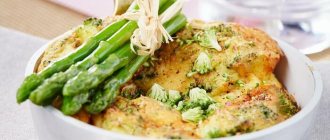Recipe: Omelette
1 serving 150 grams
Cooking technology: before preparing an omelet, eggs must be washed to remove dirt and dust. Milk and salt are added to the prepared egg mass. To get a beautiful, fluffy omelette, you must follow the ratio of 1 egg (40 g), 15 g of milk and 0.5 g of salt. The mixture is thoroughly stirred and poured onto a greased baking sheet. Then the container with the omelette mixture is placed in the oven and baked at a temperature of 180-200°C until cooked.
You can also fry the omelette in a frying pan in the form of an oval pie. The egg mixture for the omelette is poured into a heated frying pan with melted butter, the mixture is stirred until it begins to thicken, then the edges of the omelette are folded with a knife from both sides towards the middle, giving the dish an oblong shape.
When serving, pour melted butter over the omelet.
How many calories are in an omelet with tomatoes?
The calorie content of an omelet with tomatoes increases by the energy value of vegetables: 100 g of tomato – 30 kcal. An omelet with tomatoes produces more liquid, which can be removed in various ways.
Tomatoes, bell peppers, pre-fried onions can be placed:
- In an omelette with sausage;
- In an omelette with ham;
- In an omelette with sausage;
- In an omelet with cheese, lard and other products with a high degree of fat content.
Nutritionists rightly believe that, taking into account the quality of modern sausage and dairy products, it is better to dilute an omelet with vegetables with “good” water, fry in vegetable (olive) oil, without any meat additives at all, sprinkle the finished product with various herbs (dill, parsley , basil). To reduce the energy value of an omelet, you can remove the yolk from the eggs by adding a certain amount of flour to the omelet (exactly how much depends on the person’s culinary preferences).
Directions
Omelette
IngredientsDirections
Table 1
| Products | Weight | Squirrels | Fats | Carbohydrates |
| Chicken egg | 120 gr | 15.24 | 13.8 | 0.84 |
| Pasteurized milk 2.5% fat | 45 ml | 1.31 | 1.13 | 2.16 |
| Butter 82.5% fat, traditional | 10 g | 0.05 | 8.25 | 0.08 |
| Salt | 1 g | 0 | 0 | 0 |
| Exit | 150 | 16.6 | 23.18 | 3.08 |
Is it possible to have scrambled eggs and other egg dishes when losing weight on a diet?
When losing weight, it is better to eat boiled eggs. Thus, the product retains beneficial substances and reduces the risk of salmonella infection.
An omelet is also an excellent breakfast option, but not everyone who is losing weight knows how to make it correctly. To make it dietary, you need to use low-calorie ingredients, for example, non-starchy vegetables (zucchini, bell pepper, tomato, onion), lean meat, milk, etc.
Important! Do not grease the frying pan; it is better to use non-stick cookware. It is recommended to avoid salt or limit its amount. Sausages, store-bought sauces, and fatty foods are prohibited during weight loss. There are many omelet recipes that you can eat while on a diet.
Protein contains a minimum of calories, you can eat it daily and more than 3 pieces per day. There are a variety of protein omelet recipes that will help satisfy your hunger and speed up the fat burning process.
It is better to avoid raw eggs, since the protein from them is absorbed much worse than from boiled ones (50% from raw, 90% from boiled). If you regularly consume the product raw, the risk of salmonellosis is higher. This is an acute intestinal infection, which manifests itself as damage to the gastrointestinal tract and symptoms of intoxication. Raw eggs contain avidin, which interferes with the absorption of some B vitamins. After heat treatment, this substance is destroyed.
When losing weight, it is forbidden to eat scrambled eggs in large quantities, using oil, salt, spices, and fatty foods. But there are also many recipes for this dish, including dietary options. To prepare a hearty but low-calorie breakfast, use a minimal amount of olive oil (or no olive oil), sea salt. Combine the dish with fresh vegetables and herbs. Scrambled eggs can be eaten no more than 1-2 times a week.
The best time to eat eggs is in the morning. Such a breakfast satisfies quickly and for a long time, then a person eats less food during the day. Although steamed egg white omelette can be eaten even in the evening .
Calculation of the calorie content of the recipe per 150 grams
The calculation of the calorie content of 150 grams of the recipe is based on the summarized indicators of BZhUK (abbreviation: proteins-fats-carbohydrates-acids) of the ingredients from table (1) involved in the preparation. The data was taken from the database of the “products” section of the website and brought into line with the final yield of the dish (net).
Our example involves proteins - 16.6 grams, fats - 23.18 grams and carbohydrates - 3.08 grams, contained in 150 grams of the recipe. Next we perform the calculation:
Energy value of 150 grams of recipe = 16.6 (proteins)*4 + 23.18 (fat)*9 + 3.08 (carbohydrates)*4 = 66.4 + 208.62 + 12.32 = 287.3 kcal
Nutritional value of the dish
BJU of a classic omelet: proteins – 10%, fats – 16%, carbohydrates – 0.7%.
The nutritional value and benefits of a dish are determined by its main component – eggs. This product is rich in vitamins: B2 and B3 (mainly in the protein), A, B1, B5, B9, B12, E, D and H (mainly in the yolk).
The composition of egg whites includes proteins (including ovomucoid, which is responsible for causing allergies), a small amount of fats and carbohydrates, and important enzymes.
The yolk also contains proteins (a little more than white), it also contains cholesterol, fats and carbohydrates.
This is interesting! The yolk makes up about 1/3 of the mass of the egg, while it is 8 times more caloric than the white (352 and 44 kcal per 100 g, respectively).
Chicken eggs contain micro- and macroelements important for health such as phosphorus, potassium, calcium, magnesium, iron and zinc. Manufacturers can also enrich the product with iodine or selenium.
To improve taste and increase nutritional value, add tomatoes, green onions, dill, parsley, mushrooms, sour cream, cheese, sausage, and bacon to the omelette. Vegetables and herbs enrich the dish with vitamins and add very few calories, and animal products can significantly increase the energy value of the finished dish. For example, one medium-sized ripe ground tomato (50-60 g) will add 39 kilocalories - the same as a small piece of cheese weighing 10-12 g.
Calorie calculation for 100 grams
As an example, we will calculate a portion equal to 100 grams - this is one of the standard weight measures that determines the total calorie content of a product or recipe.
The easiest and most versatile option (suitable for calculating any volume of a product or ready-made dish) is the calculation by multiplying the resulting calorie content (150 grams) by a factor of 0.67, which is the result of division (100 g / 150 g).
Calorie content of 100 grams of serving = 287.3 * 0.67 = 192 kcal.
In addition, in the same way you can calculate the content of BZHU in the composition of a portion:
- Protein = 16.6 * 0.67 = 11.122 ≈ 11.1 g.
- Fat = 23.18 * 0.67 = 15.5306 ≈ 15.5 g.
- Carbohydrates = 3.08 * 0.67 = 2.0636 ≈ 2.1 g.
11.1 * 4 + 15.5 * 9 + 8.4 * 4 ≈ 192 kcal
Our calculated calorie content is more than 50, but less than 250 kcal, which means that an omelette is a medium-calorie dish with a high content of proteins, fats and low carbohydrates.
What is the calorie content of an omelet for 2 eggs?

It’s quite easy to understand this issue, because you just need to calculate the calorie content of each individual product and add up this data. Often the omelette is prepared in 1 serving, so there is no need to specify how many calories are in 100 g of the dish. However, in order to answer the question of how many calories are in an omelet made from 2 eggs, you need to make a few clarifications on the recipe (we take into account the classic version):
- What eggs were used? Chicken has several categories - from 2nd to selected. Accordingly, the weight of eggs ranges from 40 to 60-65 g. Calorie content changes along with it.
- What kind of milk was added to the omelet? The “lightest” and healthiest is considered lactose-free, which is often also low-fat or has a fat content of about 1.5%. Classic milk is 3.2%.
- What was the omelette fried in? It is best to make it in a dry frying pan: no calories or fat will be added. However, if it does not have a good non-stick coating, you will have to pour in vegetable oil or melt a piece of butter.
Now you can start working with specific numbers. So, 100 g of chicken egg contains 157 kcal. If you take 2 pieces, it will be 80-130 g. This is, respectively, 125-204 kcal. Next is milk: 100 g of lactose-free milk is about 33 kcal, if it is also low-fat. If usual, by 3.2%, then this is already 59 kcal. In addition, the question is its quantity. A classic omelet - when there are 50 g of milk per 100 g of eggs: then the dish comes out moderately fluffy and tender. As a result, we get the following options:
- The lightest omelet is 2 eggs, 40 g each, and the same 40 g of lactose-free milk: 138-139 kcal.
- The largest omelet is 2 eggs of 65 g each and another 60 g of classic 3.2% milk: 239-240 kcal.
The run-up is quite large, as you can see. But these are borderline values. You can totally use large eggs and skim milk, or vice versa. And do not forget that when frying in oil you will have to add its calorie content: this is approximately 5 ml of vegetable oil or 45 g, or 10 g of butter - 77 kcal.
Vitamin content
table 2
| Vitamins | Content | Daily norm |
| C (ascorbic acid) | 0.18 mg | 0.3 % |
| A (retinol) | 255.81 mcg | 25.6 % |
| E (α-, β-, γ-tocopherols) | 0.55 mg | 5.5 % |
| D (lamisterol) | 1.88 mcg | 75.1 % |
| B1 (thiamine) | 0.06 mg | 4.2 % |
| B2 (riboflavin) | 0.4 mg | 22.2 % |
| B3 (PP) (nicotinamide) | 3.15 mg | 16.6 % |
| B4 (choline) | 207.83 mg | 41.6 % |
| B6 (pyridoxine) | 0.12 mcg | 6 % |
| B9 (folacin) | 6.53 mcg | 3.3 % |
| B12 (cobalamin) | 0.48 mcg | 16 % |
Omelette contains vitamins with high, medium and low levels when considered according to the approved standards for the nutritional value of the dish.
At the highest level of importance in the food value chain are:
- A, takes part in all functions of the body related to its growth and proper metabolism, preserves the structure of the cornea of the eye.
- D, takes part in the formation of bone and dental tissue.
- B2, maintains body tone.
- PP, participates in the formation of hemoglobin.
- B4, is involved in the biosynthesis of heme and proteins, cell proliferation, and tissue respiration.
- B12 is involved in many metabolic processes in the body.
Vitamins at a medium level of importance include:
- E, keeps the muscular system in good shape.
- B6, participates in the metabolism of lipids and amino acids.
Vitamins of low content include:
- C, takes part in the redox processes of the body, raises the tone of the body, strengthens the immune system.
- B1, required to normalize the nervous and muscular systems.
- B9, supports the hematopoietic and digestive system.
Benefits and harms
Eggs are a healthy dietary product, approved for various medical purposes. Steam omelet is an important source of complete protein and at the same time provides chemical and mechanical sparing of the gastrointestinal tract. An omelet (especially if prepared only from egg whites) with vegetables and low-fat cottage cheese will be useful in a weight loss diet.

Photo: blogs.tochka.net
For a long time it was believed that the cholesterol contained in the yolk can increase cholesterol levels in the blood and increase the risk of atherosclerosis, so doctors recommended eating no more than 2 eggs per week. New medical research data refute this information. Currently, the recommended consumption rate for a healthy adult is no more than 2-3 eggs per day. Regular consumption of larger amounts may have a negative impact on kidney function due to the high protein content.
Egg white can be a strong allergen. Therefore, it is recommended that young children aged 7-12 months be given only the yolk as complementary food.
Omelette is prohibited for strict vegetarians and vegans, but ovolacto-vegetarianism allows the consumption of eggs and milk, therefore, a dish prepared from these products is also allowed.
Main conclusions
Eggs are an excellent product for weight loss, which fill you up quickly and for a long time, speed up metabolism, and promote weight loss. A diet omelet is prepared with skim milk, water, non-starchy vegetables, lean meat, fruits, etc.
There are many interesting recipes for weight loss. This food is best eaten for breakfast or lunch. For dinner, a protein-based dish is more suitable; leave the yolks for the first half of the day. It is better to cook a diet omelette by steaming, in a slow cooker or oven.
Share in the comments your signature omelet recipes that you can use while losing weight.
Advice from nutritionists
Omelette is a dish that is often included in various weight loss diets. This is not surprising, because it is quite filling and nutritious, contains a large number of useful substances, and you don’t need to bother with its preparation at all. To ensure that the omelet you prepare is as dietary as possible and helps you lose extra pounds, follow these simple rules:
- cook it in a slow cooker, oven or steam instead of frying;
- the fewest calories are contained in a dish prepared exclusively from proteins (the so-called protein omelet);
- if you use milk, then choose this product with the lowest fat content;
- use low-calorie vegetables for cooking;
- Use it in the morning to “start” your metabolism.

Features of steaming, microwave, multicooker and frying pan
Steam omelette can be prepared in a double boiler or in a water bath. This version of the dish is considered the most dietary. The step-by-step recipe is practically no different from the classic one using a frying pan. First, eggs are beaten, then milk, sour cream or water is added. The mass is poured into the steamer container and cooked for 10-20 minutes.

If you don’t have a double boiler, then boil water in a saucepan, place a colander in it so that it does not touch the water, but its bottom is well covered with steam. Pour the egg mixture into greased molds and place in a colander. If you use silicone molds, discard the fat.
Vegetables, meat and fruits need to be simmered for a few minutes before adding the egg mixture. After all, eggs cook faster than other ingredients.
Prepare an omelet in a slow cooker in the same way. Additional ingredients should be cooked in the “Fry” mode for about 7-10 minutes before adding the eggs. Then you should add the base and activate “Baking” for 20 minutes.
A diet omelette in the oven is prepared on a baking sheet or in silicone molds. Only vegetables, meat and fruits are first stewed in a frying pan, and then poured into the base. Cook the dish for about 20-25 minutes at 180 degrees.
The recipe for a diet omelet in the microwave is simple and quick. Just beat the eggs, add salt, add herbs, heat the bowl in the microwave for 1 minute at 600-800 power, and then pour the mixture in and place it inside again for another 1.5 minutes.

Low-calorie omelet recipes for proper nutrition
There are many recipes for dietary omelets; they can be made from eggs, whites only, with the addition of low-fat milk or water. If you follow the cooking rules, such food can be consumed at any time of the day.
The method of heat treatment also matters. It is best to steam the dish, as it retains more nutrients.
Attention! You can use vegetables, cottage cheese, cheese and even fruits as additional ingredients. There are no fats in the dietary recipes. In extreme cases, using a small amount of olive oil is acceptable.
Avoid recipes that use flour or semolina. These components can be replaced with a small amount of starch.
If you want a fluffy omelette, then try to beat the whites into a fluffy foam. If you do this poorly, you will end up with a flat pancake.
With vegetables
A vegetable diet omelette will quickly satisfy your hunger, energize you and will not cause heaviness in your stomach. This fluffy, appetizing and light dish will appeal to those losing weight. This is a simple recipe, so even a novice cook can handle it.

Cooking instructions:
- Cut peeled carrots, 400 g of zucchini, 2 bell peppers, 1 onion into small cubes, and separate 400 grams of broccoli into florets.
- Heat 1 tbsp in a non-stick frying pan. a spoonful of olive oil and 2 tbsp. l. water, simmer carrots, zucchini, paprika, onions for 5 minutes.
- Then add cabbage and simmer for 5 minutes.
- Meanwhile, beat 4 eggs with a whisk or mixer, add skim milk, salt, and spices to the fluffy mass.
- Pour the mixture over the vegetables and fry for 5-7 minutes.
The omelette has a delicate taste and pleasant aroma. Sprinkle it with chopped herbs.
With Chiken

This recipe is dairy-free and uses water instead to reduce calories. But its taste does not deteriorate because of this. Step by step recipe:
- Cut 1 chicken breast into small pieces, simmer it in a frying pan over low heat until cooked.
- Separate the yolks from the whites of 3 eggs.
- Beat the whites with a mixer to form a thick foam, carefully combine them with the yolks, and beat again.
- With the blender running, gradually add 3 tbsp to the mixture. l. water. Add salt.
- Pour over the chicken; when the mixture rises, simmer over low heat for another 3-5 minutes.
Eat a diet omelet with fresh vegetables and herbs.
With cottage cheese
If you are tired of the classic diet omelette, then prepare a dish with cottage cheese. This is a high-protein food that will accelerate muscle growth and fat burning.

To prepare a cottage cheese omelette, follow this plan:
- Separate 2 whites from the yolks, beat them separately, and then combine as in the previous recipe.
- Separately, beat 100 g of cottage cheese with a blender. Take a product with a fat content of up to 5%.
- Combine the egg and curd mass, mix gently but thoroughly.
- Salt, add spices, chopped green onions, dill.
- Pour the mixture into a hot frying pan without oil. Cook for 5-8 minutes.
The finished dish has a pleasant creamy taste.
With cheese, beans and tomato
For this dietary omelet, you need to choose low-fat cheese. A product with this indicator of 10-17%, for example, mozzarella or ricotta, is quite suitable. The combination of young juicy beans, tomatoes, eggs and cheese gives a unique taste. This dish is recommended to be eaten for breakfast or lunch.

Recipe for making an omelet with vegetables and cheese:
- Simmer 100 g of green beans in a mixture of olive oil and water.
- After 5 minutes, add the chopped tomato to the pan. Simmer the vegetables for another 5 minutes.
- Separately beat 3 whites and yolk, then combine them. Continue beating the mass, pour 1 tbsp into it. l. water.
- Salt and add spices if desired.
- Grate 20 g of cheese and add to the egg mixture.
- Pour in the vegetables, cover the pan with a lid, cook for 5 minutes.
When serving, sprinkle the diet omelette with herbs.
Oat
Diet omelette with oatmeal is very popular among fans of healthy eating and athletes. Salmon, low-fat cottage cheese, tomatoes, herbs or even fruit are used to fill the “oatmeal pancake”.

Step by step recipe:
- Beat the white and yolk and mix them.
- Add 2 tbsp to the mixture. l. oatmeal, which can be ground in a coffee grinder before adding. It is recommended to use coarse flakes, which have more fiber.
- Pour in 1-2 tbsp. l. milk with zero fat content, salt, mix.
- Pour the mixture into a non-stick frying pan and fry on each side.
Place lettuce leaves and thin slices of salmon inside the pancake. This dish looks appetizing and tastes great.
Buckwheat
If you have buckwheat porridge left in the refrigerator, then prepare a diet omelet from it. The recipe uses 3 whites and 1 yolk, which is important during a strict diet.

Cooking instructions:
- Beat the whites and yolk and mix them.
- Pour 1 tbsp into the mixture. l. skim milk, add spices.
- Add 100 g of porridge, a little chopped green onion, stir.
- Pour into a dry frying pan, cook for 5-7 minutes.
Serve the dish with fresh vegetables.
With apples
Those with a sweet tooth will surely love the sweet omelette with apples. Prepare and eat this dessert for breakfast.
Step by step recipe:
- Cut the apple (sweet variety) into thin slices, simmer in a frying pan, the bottom of which is greased with a minimum amount of butter. Lightly dust fruit with powdered sugar and cinnamon (if desired). Simmer until soft.
- Beat 2 eggs and pour them over the apples.
- Simmer for 5-7 minutes.
This dish tastes like pancakes or biscuits. Instead of apples, you can use pears, peaches, apricots, and berries.









